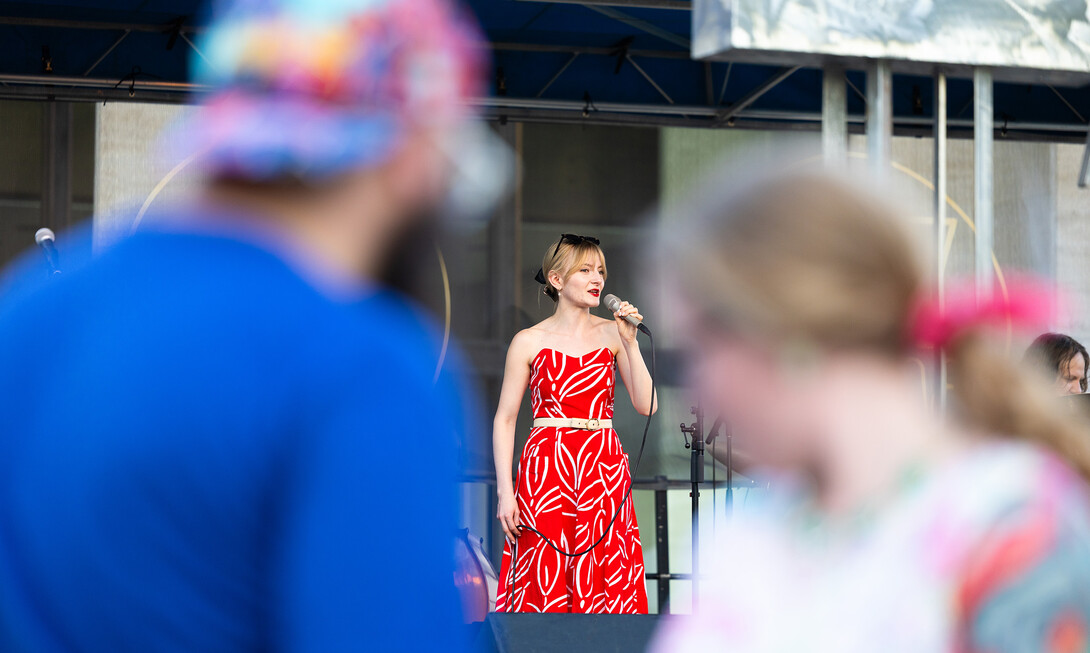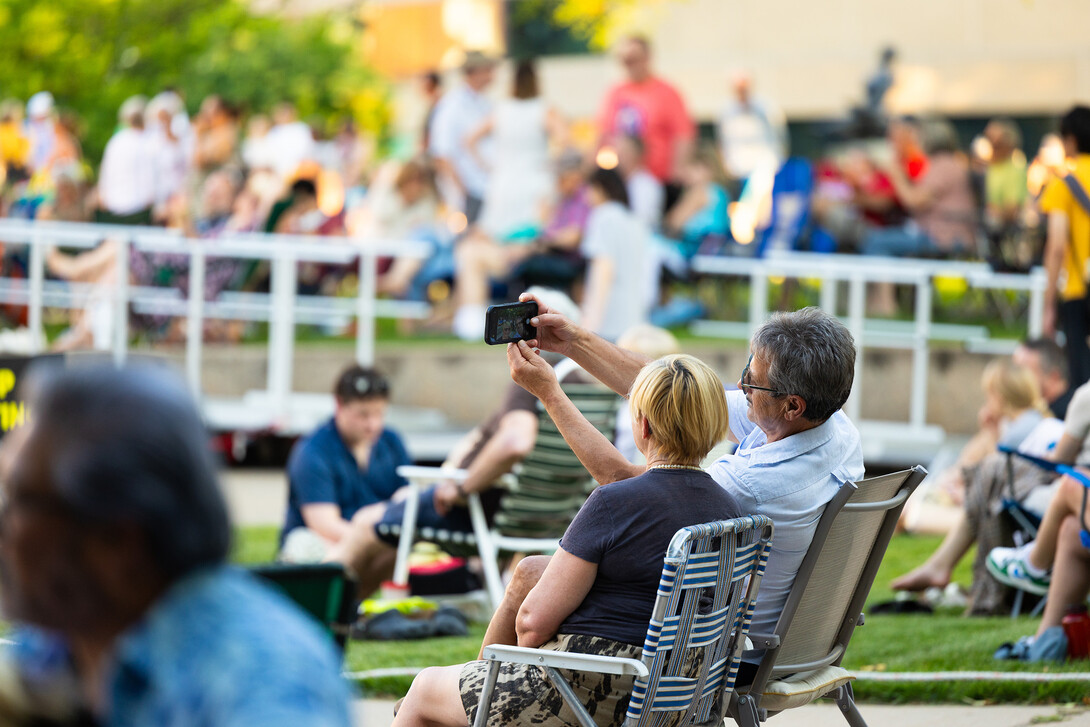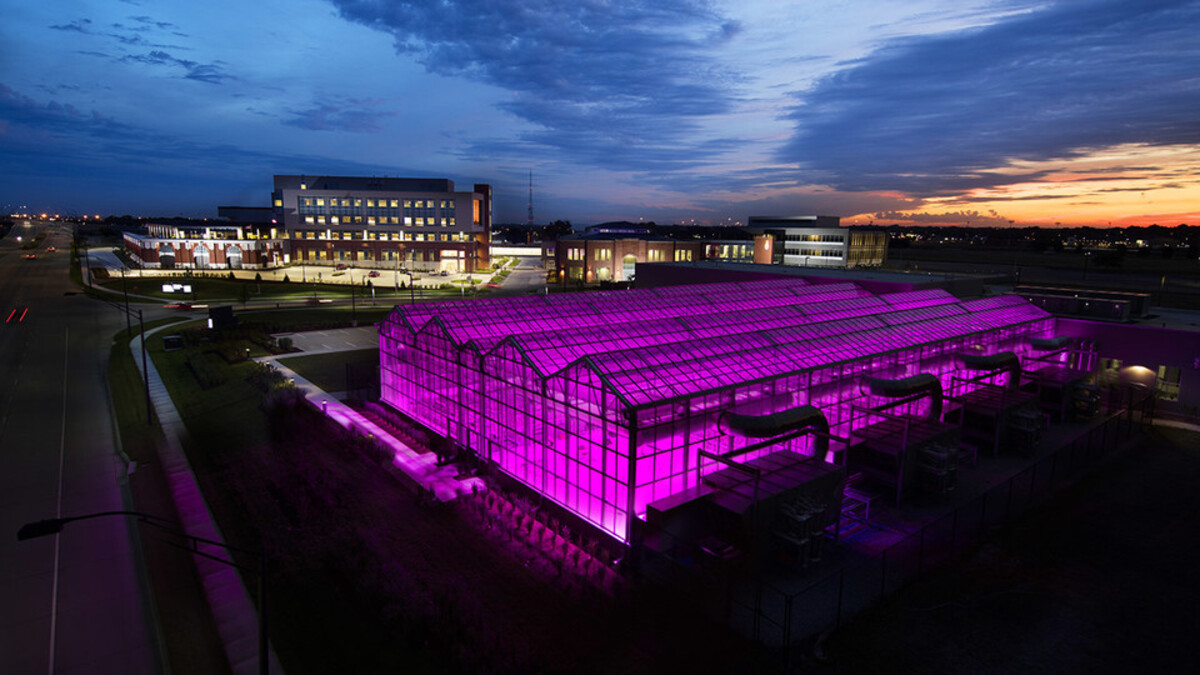
It all began with a bit of brainstorming.
The year was 1991 and Kathy (Beggs) Piper (’61, ’83) was executive director of the Nebraska Art Association (which began operating as the Sheldon Art Association in March 2008). Tasked with planning arts programming and education for the entire state, the association was hitting a creative roadblock and needed fresh ideas, particularly for attracting people to Sheldon Museum of Art.
Piper had recently attended a conference for young friends of art, which got her wheels spinning.
“I can’t even remember anything about the conference, except that we talked about doing things that would bring people to our organization,” Piper said. “And that’s sort of how it got started.”
Concurrently, she was noticing that multiple museums nationwide were hosting jazz concerts in an effort to entice new audiences. Just up the road in Omaha, in fact, was one such event: Jazz on the Green, which began in the summer of 1985, organized by the Joslyn Art Museum.
That summer, Sheldon’s curator of education, Karen (Oneth) Janovy (’93), was actively involved in a statewide arts education initiative. She was splitting her time between the Joslyn and the Sheldon, helping with teacher institutes.
“I remember standing in that office and saying to Kathy one day during that summer, ‘Joslyn has Jazz on the Green every summer, and maybe that’s something that Sheldon could do,’” Janovy recalled. Piper agreed and saw natural alignment with the information she’d just picked up at the conference. She brought the idea to Sheldon’s board to get their buy-in.

The planning committee picked June because in a state where the weather can dramatically change within a matter of minutes, it seemed like a relatively safe bet.
“June is always a pleasant month as a general rule,” Janovy said. “Later in the summer, it wouldn’t be nearly as pleasant.”
Little did they know, they’d just given birth to what would become the Lincoln tradition of Jazz in June. Those first few concerts in the summer of 1991 were all-hands-on-deck affairs, requiring many dedicated volunteers and lots of resourcefulness. The event had no real budget when it launched.
“I tried to get together groups of people that I didn’t have to pay because we had no money at that point,” Piper said.
She tapped David Sharp (’91), then an adjunct professor in the School of Music, for his expertise and assistance with finding musicians who were willing to perform for free.
“I was running the jazz program at the time,” Sharp said. “She called me with an idea that she wanted to put on a concert series with jazz, kind of modeling it after the success of Jazz on the Green in Omaha. She didn’t know anything about musicians, so she asked me to help with hiring groups.”
Jazz, he explained, is a great way of learning music because it takes so many skills to become a successful jazz musician. It’s about being equal parts improviser and traditionalist.
“You have to know your instrument really well,” Sharp said. “You got to know a lot about music theory and have a good sense of rhythm. You’re a composer all the time when you play.”
Introducing new audiences to jazz musicians they wouldn’t normally be exposed to felt like a directive he had been primed to spearhead. To kick off the inaugural Jazz in June, Sharp lined up four performers: Nebraska Jazz Orchestra, The Foreheads (which Sharp was a part of, playing saxophone), Hornithology and Irie.
For Sharp, this up-and-coming music series would be doubly beneficial. He could leverage his network of musician friends while also getting some precious stage time himself.
“It was an opportunity to play,” he said. “I’ve always tried to promote jazz performances because I’ve been a college jazz instructor, and jazz education and outreach were always important. Certainly at that time, I was trying to build the music scene in Lincoln, particularly the jazz scene.”
With the lineup locked in, Piper and her ragtag team of art and music aficionados were on the cusp of pulling it off. All they had to do was press play. The first Jazz in June concert took place on June 2, 1991. It did not take long for the event organizers to realize they had struck gold. “Yeah, I was surprised at the number of people that came originally,” Piper said. “It was joyous. The weather was perfect.”
She had “no idea” how many people were going to be there. When families and friend groups began pouring onto the lawn, she perched near the back of the Sheldon and watched, in a state of stunned satisfaction.
“They just kept coming and it was wonderful,” Piper said, estimating that the first Jazz in June drew hundreds.
Connection — kids’ connection, community connection. It’s probably the one event every year the community comes together for, regardless of what craziness is going on. The community always comes together for Jazz in June.
What Janovy most vividly remembers is how “tremendously successful” she felt seeing those swaths of attendees sprawled out along the lawn, ears perked, ready for an evening of locally sourced song and sound. “It became clearly obvious that this was something that people in Lincoln would appreciate, value, and drive down there for,” Janovy said.
Indeed, there was only so much time allotted for shock and awe. The newly minted Jazz in June crew had work to do to make sure the event went smoothly. “They schlepped ice and all kinds of stuff out into the gardens for each one of those evenings,” Janovy said. “They engaged multiple volunteers — it was an amazing, huge effort.”
As curator of education at the Sheldon, Janovy wrote up information about the gallery’s iconic sculpture garden, which provided a picturesque backdrop for the outdoor concerts. Those artistic factoids were typically shared and discussed during intermission. “The audience was receptive to that as well,” Janovy recalled. “Who knows how many people would go through those gardens on their way to the game, but did they ever stop and look at them?”
She shared that some Jazz in June attendees would hear about the sculptures in the summertime, and as they passed in through the gardens on the way to the football stadium, they would mention their newly acquired artistic insights. “They would say to their relatives and their family, ‘Oh, we learned about this one last year at Jazz in June,’” Janovy said. “How much more rewarding could that kind of input have on a person’s life? That’s just so rewarding, so gratifying.”
In that first decade, Piper recounted only one occasion when they had to move the event indoors due to rain. “But otherwise, it was always beautiful,” she said. “I loved all the people that came. I think it became a summer tradition just a couple years after it started.”
One standout moment for Sharp happened during those early days in the 1990s. He’d been working on an arrangement and wanted to recruit local groups to perform it together.
“I had an idea for one show being a gospel jazz night,” Sharp said. “I had arranged some music; all three groups were playing more gospel, jazz-oriented things. I remember the reception for that was just unbelievable. Of all the performances I did at Jazz in June early on, that one was like, wow.”
Thanks to community support early on — and eventually corporate sponsors — Jazz in June was able to pay performers and keep the concerts free and open to the public.
“It’s for the people,” said Martha Florence (’80), who served as chair of Jazz in June for more than 20 years. “If we actually started charging, then we would limit those folks that got to take advantage of it. Sometimes, people get together for only that one time each month; they look forward to seeing each other every Tuesday in June.”

Formerly the director of community engagement at NET (she retired in 2020 after 44 years with Nebraska’s public broadcasting system), Florence became involved with Jazz in June in the mid-1990s. Back then, she was on the Sheldon board and had some history promoting local artists. Her experience and skillset uniquely positioned her to help build on the event’s ever-growing momentum.
It was around the same time that Berman Music Foundation founder Butch Berman joined the Jazz in June committee. For more than a decade, the Berman Music Foundation was instrumental in elevating the reputation of this grassroots music series.
As the years went on, the caliber of the performers kept increasing. Organizers went from sourcing talent locally and regionally to nationally and internationally. “(Berman) was the sponsor for many, many, many years, and he was able to pull national folks because he knew them personally,” Florence explained.
The crowds continued to balloon in size, tipping into the thousands. “It grew every week, and then every year it grew,” Piper said. “It became just an exciting event. It was something that, as far as I was concerned, put Sheldon more on the map.”
Jazz in June had emerged as a worthwhile attraction in and of itself, garnering attention from folks across the globe. It was a must-see musical stop for fans and artists alike.
“We got notoriety, and people were calling us from around the country,” Florence said. “Other artists would tell other artists and then it would go throughout the world. That’s the beauty of Jazz in June — it’s now a destination, especially for music lovers.”
Notable acts throughout the years have included Eldar Djangirov, Kendra Shank Quartet, The YAYennings Quartet, Arturo Sandoval and Victor Lewis, among countless others.
“There are (performers) that most people wouldn’t get to see otherwise or couldn’t afford to see otherwise, because we’ve always been free,” Florence said.
By the time Berman passed away in 2008, Piper had left her post as executive director of the Sheldon Art Association and Sharp was no longer teaching at the music school. Janovy was still in her curatorial role at the museum, though she would eventually retire three years later, in 2011.
“(Jazz in June) was such an invaluable experience in my life,” Janovy said. “And you just stand back and relish that kind of an experience and an opportunity in which you feel as though you played a significant part.”
To cite one music legend, the times they were a-changin’. By the late 2010s, oversight and organization of Jazz in June had shifted from the Sheldon Art Association to a campus-wide committee and the Lied Center for Performing Arts.
Florence, meanwhile, remains. While she’s no longer involved in the “heavy lifting” of planning, she usually serves as the announcer at the concerts once June rolls around. “I’m the connection, in my mind at least,” she said. “I’m the one constant, so that’s why it’s important to be there.”
Having witnessed Jazz in June’s evolution over the decades, Florence has found the Lied Center and its executive director and chief artistic officer, Bill Stephan, to be ideal collaborators for ensuring the event’s continued success.
“It’s been really easy working with them,” Florence said. “What they bring to the table is a lot of experience, a lot of opportunities, and a lot of connections around the country, so that works out well. We have a lot more Grammy Award winners — by joining the Lied Center, we regained that connection again.”
Today, Jazz in June is as popular as ever, drawing crowds numbering in the thousands. Blankets are stretched across slices of lawn, picnics are packed, and family and friends both old and new gather for an evening of musical enjoyment.
Just as it was in 1991, Jazz in June is still a community-powered event. Without the steadfast financial support from attendees, Lincoln’s longest-running outdoor music series couldn’t stay afloat. And the city would stand to lose something even more valuable than money: a shared link to their community.
“Connection — kids’ connection, community connection,” Florence said. “It’s probably the one event every year the community comes together for, regardless of what craziness is going on. The community always comes together for Jazz in June.”







